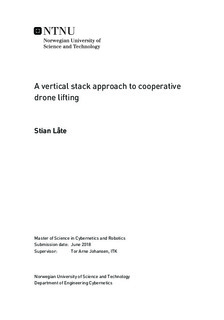| dc.description.abstract | In the Pyeongchang 2018 Winter Olympics, over 1200 coordinated drones displayed an impressive lightshow for the opening ceremony. This is a testimony of the fact that the field of drone swarm technology has advanced rapidly in recent years. In future development, moving from coordinated to cooperative utilization of drones will lead to a more commercially viable way of transportation and delivery through drone lifting. Inherent challenges of established methods for cooperative drone lifting are limited scalability, and complicated collision avoidance. This report presents a novel approach to cooperative drone lifting which aims to alleviate these challenges.
In the new approach, multiple drones are interconnected in a vertical formation. The physical connections are made as two rigid, lightweight rods connected by freely rotating joints. In this way, the gravitational pull of a hanging payload can be propagated upwards, and distributed among the cooperating drones. The benefit of this is extended lifting capabilities and system redundancy. The examination of this novel concept was divided into two main parts, one was a derivation of a system model with subsequent simulations, and the other was a real-world implementation.
The implementation involved two drones, equipped with a Pixracer autopilot, RTK positioning equipment, and an onboard companion computer, providing a framework for custom control design. The companion computer was configured to communicate with a stationary system which sends reference positions and operation plans, and which gives the user a system level overview. Sensor accuracy and aerodynamic influence between drones were measured using the physical platform.
A new model for simulating the dynamics of the lifting scheme was developed. By making conservative simplifications and by finding constraint forces from solving the Udwadia-Kalaba equation, simulations including several connected drones were made possible. System control was reached by an implementation of three control layers: single drone, formation and formation guidance. An approximation of the aerodynamic influence between the cooperating drones, found from the realized system, was included, and its implications studied.
Single drone flight was achieved using the realized system. With the simulated system including aerodynamic influence, a vertical formation containing ten drones successfully traversed the desired path. | |

